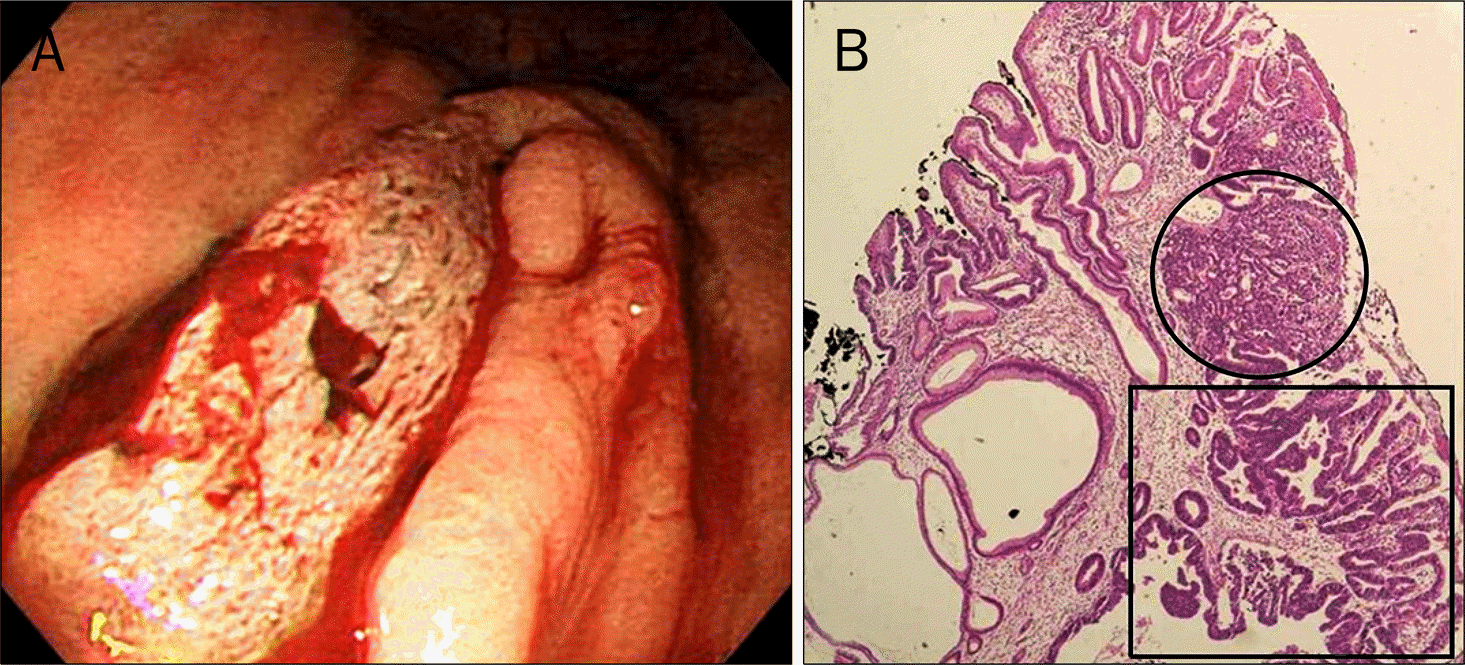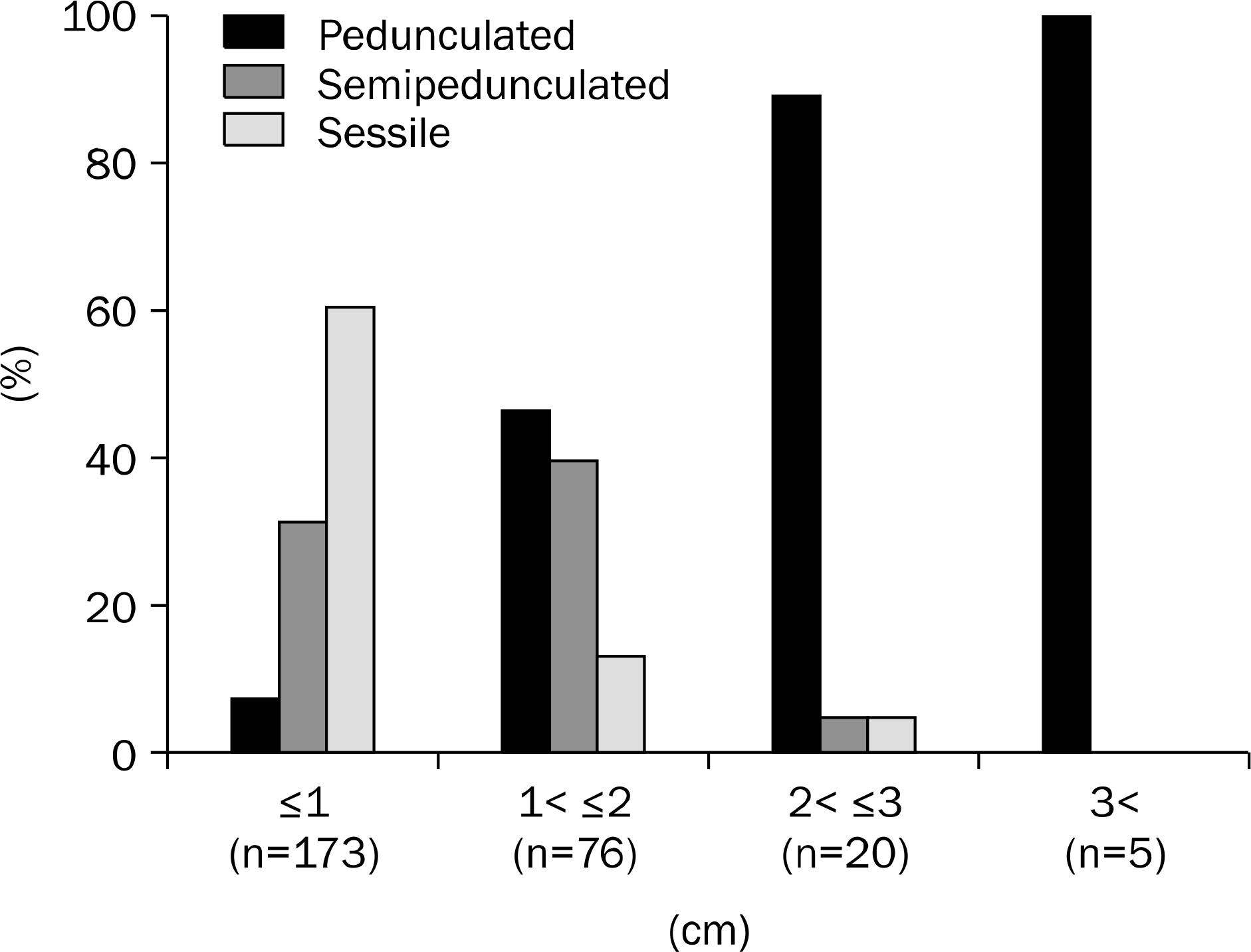Abstract
Background/Aims
Hyperplastic polyps (HPs) are the most common cause of all benign epithelial gastric polyps, constituting 30 to 93%. Although gastric HPs are usually considered as benign lesions compared with adenoma, neoplastic transformation has been known to occur rarely. We aimed to identify the clinical factors of gastric HPs predicting for neoplastic transformation.
Methods
Between January 2002 to August 2010, a total of 274 gastric HPs, which had been removed by endoscopic polypectomy or surgical resection from 210 patients, were analyzed retrospectively.
Results
Neoplastic transformation was found in 15 cases (5.5%) of 274 HPs including 10 cases of low grade dysplasia (3.7%), 2 cases of high grade dysplasia (0.7%) and 3 cases of adenocarcinoma (1.1%). Neoplastic transformations were significantly associated with >1 cm in size (n=10 [66.7%] vs. n=91 [35.1%], p=0.024), with pedunculated shape (n=9 [60.0%] vs. n=62 [23.9%], p=0.002), with previous history of gastrectomy (n=3 [20.0%] vs. n=3 [1.2%], p=0.002) and with synchronous neoplastic lesions occurring elsewhere in the gastric mucosa (n=5 [33.3%] vs. n=31 [12.0%], p=0.021). However, no significant difference was found between HPs with and without neoplastic transformation in terms of age, sex, number of polyps detected per patient, location, macroscopic appearance such as erosion, hyperemia.
Conclusions
Neoplastic transformation of gastric HPs had significant relationships with >1 cm in size, pedunculated shape, postgastectomy state, and synchronous neoplastic lesion. Therefore, endoscopic polypectomy should be considered in these HPs to avoid the risk of missing HPs with neoplastic potential.
Go to : 
References
1. Ming SC, Goldman H. Pathology of the gastrointestinal tract. 1st ed.Philadelphia: WB Saunders;1992.
2. Deyhle P. Results of endoscopic polypectomy in the gastrointestinal tract. Endoscopy. 1980; (Suppl):35–46.
3. Carmack SW, Genta RM, Schuler CM, Saboorian MH. The current spectrum of gastric polyps: a 1-year national study of over 120,000 patients. Am J Gastroenterol. 2009; 104:1524–1532.

5. Hattori T. Morphological range of hyperplastic polyps and carcinomas arising in hyperplastic polyps of the stomach. J Clin Pathol. 1985; 38:622–630.

6. Goddard AF, Badreldin R, Pritchard DM, Walker MM, Warren B. British Society of Gastroenterology. The management of gastric polyps. Gut. 2010; 59:1270–1276.

7. Deppisch LM, Rona VT. Gastric epithelial polyps. A 10-year study. J Clin Gastroenterol. 1989; 11:110–115.
8. Muehldorfer SM, Stolte M, Martus P, Hahn EG, Ell C. Multicenter Study Group "Gastric Polyps". Diagnostic accuracy of forceps biopsy versus polypectomy for gastric polyps: a prospective multicentre study. Gut. 2002; 50:465–470.

9. Han AR, Sung CO, Kim KM, et al. The clinicopathological features of gastric hyperplastic polyps with neoplastic transformations: a suggestion of indication for endoscopic polypectomy. Gut Liver. 2009; 3:271–275.

10. Abraham SC, Singh VK, Yardley JH, Wu TT. Hyperplastic polyps of the stomach: associations with histologic patterns of gastritis and gastric atrophy. Am J Surg Pathol. 2001; 25:500–507.

12. Dirschmid K, Platz-Baudin C, Stolte M. Why is the hyperplastic polyp a marker for the precancerous condition of the gastric mucosa? Virchows Arch. 2006; 448:80–84.

13. Orlowska J, Jarosz D, Pachlewski J, Butruk E. Malignant transformation of benign epithelial gastric polyps. Am J Gastroenterol. 1995; 90:2152–2159.
14. Nakamura T. Malignant change of gastric polyp, with special reference to histopathological classification. Stomach Intestine. 1968; 3:737–747.
15. Daibo M, Itabashi M, Hirota T. Malignant transformation of gastric hyperplastic polyps. Am J Gastroenterol. 1987; 82:1016–1025.
16. Hizawa K, Fuchigami T, Iida M, et al. Possible neoplastic transformation within gastric hyperplastic polyp. Application of endoscopic polypectomy. Surg Endosc. 1995; 9:714–718.

17. Rosen S, Hoak D. Intramucosal carcinoma developing in a hyperplastic gastric polyp. Gastrointest Endosc. 1993; 39:830–833.

18. Orlowska J, Pietrow D. Multifocal gastric carcinoma arising from hyperplastic and adenomatous polyps. Am J Gastroenterol. 1990; 85:1629–1634.
19. Zea-Iriarte WL, Sekine I, Itsuno M, et al. Carcinoma in gastric hyperplastic polyps. A phenotypic study. Dig Dis Sci. 1996; 41:377–386.
Go to : 
 | Fig. 2.(A) Endoscopic finding of the case of hyperplastic polyp with neoplastic transformation. A 4.0×1.2 cm sized pedunculated lesion with spontaneous bleeding is noted on the greater curvature side of the mid body in a patient with melena. Endoscopic snare polypectomy was immediately performed for the hemostasis. (B) Microscopic finding showed focal adenocarcinomatous transformation (cir-cle) and dysplastic foci (square) in the background of the hyperplastic polyp (H&E stain, ×40). |
Table 1.
Clinical and Pathological Characteristics of Enrolled Gastric Hyperplastic Polyps (n=274)
Table 2.
Summary of Data on Gastric Hyperplastic Polyps with Neoplastic Transformations
M, male; F, female; HP, hyperplastic polyp; S, sessile; SP, semipedunculated; P, pedunculated; LGD, low grade dysplasia; HGD, high grade dysplasia; Adenoca., adenocarcinoma; OP, operation; B-II, Billoth II; RG, reactive gastritis; CSG, chronic superficial gastritis; HpG, Helicobacter pylori (H. pylori) gastritis; NA, not available.
Table 3.
Characteristics of Hyperplastic Polyp with or without Neoplastic Transformation




 PDF
PDF ePub
ePub Citation
Citation Print
Print



 XML Download
XML Download